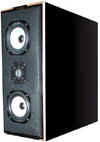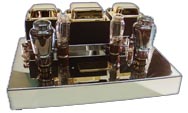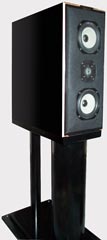The Rosinante Dulcinea Loudspeaker & The Art Audio Jota Amplifier
| The Rosinante Dulcinea Loudspeaker & The Art Audio Jota Amplifier |
| Combo Kings or Combo Queens? |
| Clement Perry |
| 5 November 2001 |
 Specifications
Specifications
Rosinante specs:
Tweeter: 25mm inverted dome, coated surface
Woofer/Midrange: Two 5″ cast woven, polyglass cones.
Frequency: 35Hz to 22kHz
Impedance: 8 Ohms
Sensitivity: 91dB
Dimensions 21.5″ H × 9.5″ W × 20″ D
Price: $6200 including Stands
Argent/Rosinante
Box 612, 602 Acorn, Eudora KS 66025
785 542 3922
website: www.roomlens.com
 Art Audio Jota specs:
Art Audio Jota specs:
Input sensitivity: 400mV
Input impedance: 180 k/ohms
Output impedance: 1.1 ohms
Frequency response: 20Hz to 20kHz – 0.5dB (full rated output)
Weight: 70 lbs.
Size: 18 1/2 × 10″ × 14″ (W × H × D)
Tube Compliment
(2) KR VV32B output tubes
(2) Mullard CV 378 (GZ 37) rectifiers tubes
(2) 6922/ 6DJ8 gain stage
(2) 12 BH7 additional gain and cathode follower
NOS tubes are an available option for driver stages – please inquire.
Art Audio USA
34 Briarwood Road, Cranston, Rhode Island 02920
Phone: (401) 826-8286; fax: (401) 826-3903
Website: www.artaudio.com
Price: $7,995
Dedicated to the life and spirit of Larry Davidson who gave his life helping others evacuate the World Trade Center on September 11, 2001.
You will be missed dearly.
Synergy could give a damn what a component costs, weighs or how many Editor’s Choice Awards it received from hi-fi magazines. Go ahead, purchase the most outlandishly priced or talked about piece of electronics and see for yourself that it doesn’t produce what many audiophiles describe as “magic” with the system you’ve already in place. It too will sound less enchanting than, lets say, the Bose Wave Radio (Hey, watch that, my mother owns one). That is precisely what makes this hobby so mysterious, as well as wonderfully delightful. I am fully aware of, and always left scratching my head over, the many highly touted setups, expensive as all get out, that have left me pondering why? Why all this dedication to property and prestige rather than component connectivity?
They say the answer, or if you prefer, the proof, is in the pudding. Well, the obvious absence in synergy was painfully apparent in the Harlem Room at the Stereophile Show held last spring (why name it the Harlem Room? I haven’t seen anyone near 125th Street with that level of gear! Come to think of it, I haven’t seen this level of gear anywhere). Notwithstanding the less-than-optimal show conditions, these very posh “state of the art” electronics suffered miserably in the very same way much less expensive and affordable rooms did. Again, synergy could give a damn about the cost of that room’s components.
Unfortunately, while talking to a well-known speaker designer, he explained, in part: “it is impossible to predict solely from the price, size or, for you techies, the nominal impedance of a loudspeaker, what its current demands might be, for example, through the power range of a London Symphony Orchestra recording. The reasons are quite numerous, but could be narrowed down easily to the current demands of a loudspeaker greatly exceeding its rated impedance as the most probable cause. Of course, unpredictable crossover network reactance, driver excitation, and out-of-phase currents don’t help either. Therefore, the most successful means to establish amp/loudspeaker harmonious compatibility is through listening. It ain’t high tech, but its damn effective.” I could not agree more heartily!
My guess is that this talented designer was saying all that to unequivocally state that, when components form a distinctive fidelity with each other -a unique, perfectly matched partnership, as tight as a soul brother handshake, whatever the price- they should always be lauded. Amen!
One such allegiance that’s been receiving numerous “oohs” and “ahhs” at my residence happens to be Ric Cummins’ Rosinante Dulcinea Mini-Monitor Loudspeaker. This is the very same Ric, by the way, that invented and manufactures both Dark Matter and the Room Lens (seems as busy as a one legged man in an ass kicking contest, doesn’t he?). Strapped to the Art Audio Jota (pronounced Hota) tube amplifier, designed by Joe Fratus, there becomes immediately noticeable an unmistakable rightness to the sound that has left everyone who’s come over for a listen slack jawed.
Strapped to the Art Audio Jota (pronounced Hota) tube amplifier, designed by Joe Fratus, an unmistakable rightness to the sound becomes immediately evident and leaves anyone who’s listening slackjawed.
Now let me qualify my findings of this super dynamic duo…
The Rosinante Dulcinea takes the very same tradition and high performance from its higher priced sibling, the futuristic looking Gabrielle, built on the very same impeccable standards except in a smaller, more affordable but highly attractive package of wood cabinetry and design. Mine came in the glossy piano finish with its nicely sculpted beveled edges.
 I would qualify the Dulcinea as a large mini-monitor in terms of its sheer height and depth. On the front baffle, composed exclusively of his Dark Matter damping material, are two 5″ Focal cast basket midrange/woofer drivers centered around a 1″ inverted Focal dome tweeter in a D’Appolito configuration. The rear of the Dulcinea reveals a ported design with a single set of five-way binding post located directly below it. Sorry, but biwiring is not an option in the Dulcinea. This seems to be the standard these days with many great designs (ala the Talon Khorus X).
I would qualify the Dulcinea as a large mini-monitor in terms of its sheer height and depth. On the front baffle, composed exclusively of his Dark Matter damping material, are two 5″ Focal cast basket midrange/woofer drivers centered around a 1″ inverted Focal dome tweeter in a D’Appolito configuration. The rear of the Dulcinea reveals a ported design with a single set of five-way binding post located directly below it. Sorry, but biwiring is not an option in the Dulcinea. This seems to be the standard these days with many great designs (ala the Talon Khorus X).
The Dulcinea’s insides look nothing like its rectangular exterior. Inside its walls reside a two layer laminate (1 3/8″ thick) of MDF, separated by a visco-elastomer (type of Sorbothane) damping, sculpted in a pattern that not only removes all parallel surfaces and corners, but literally guides internal sound pressures in addition to creating a much smoother energy flow pattern. Crossover for the midrange/woofers is 2nd order, while the tweeter employs a 3rd order, all in phase. Silver wire, solder and high purity foil inductors are used throughout while, get a load of this, cryogenically treated quantum filtration products from none other than Mr. Jack Bybee, are used internally for added (super-) conductivity starting right at each driver. This is said to lower the speaker’s inherent noise floor. The Dulcinea’s custom-made stands resemble the Room Lens except in their height and thickness. As you might have guessed, a healthy portion of Dark Matter went into their design to further eliminate floor and airborne vibrations. Too bad they weren’t able to withstand the recklessness of my UPS deliveryman. He slightly damaged one stand but luckily I discovered an easy fix.
FYI, dear Home Theater buffs, the Dulcinea’s can be bought separately and since they’re internally shielded, can be placed near your big screen or two-piece projection rig.
The Art Audio Jota name is derived from the jamboree held annually around the globe. It revolves around lots of food, folks and fun, and plenty of wine and song. Joe, like myself, hails from Brooklyn, New Yawk and thought so highly of the celebration, witnessing it on television, he named an amplifier after it! Specifications read like a solid contender for Single Ended Champ: 20-watts-per-channel SET, zero-feedback, dual mono design, with pure class-A output and an automatic biasing circuit. The circuit board is a 2oz copper traced, military-spec’d and multi-layered, while the power supply is a solid state design with soft start using CV 378 (GZ 37) tubes in series, two pi filters and a choke filter. Add to that arsenal, not your typical run-of-the-mill SET, but a SET designed around the infamous-somebody pass the popcorn-Riccardo Kron’s KR Enterprises 32B tube! Finally, these output devices are slickly mounted on a sophisticated plate to isolate them from chassis borne vibrations.
Options include bigger output tubes from KR Enterprises as well NOS for the driver stage. In addition, for all you purists out there, a volume attenuator for direct connectivity to your loudspeakers makes simplicity and hookup a snap.
I don’t want to go too deep into detailing its specs because there is so much more I could say about the Jota’s physical beauty and smart design. Heck, go see it, better yet, touch it for yourself. Most importantly, give it a listen. I should state for the record, being the romantic that I am, my favorite feature is its recessed powder-blue (power-on) indicator lights, located on each side of its bronzed nameplate. Damn this baby’s sexy! Dim the lights, turn this baby on and you’ll be smitten even before the music begins.
The Dulcinea/Jota was used with an assortment of cables from both Analysis Plus, including the Power Oval A/C cords, and Wasatch Cables interconnects. Robert Lee’s Acoustic Zen Special Matrix speaker cable proved to be a near perfect match as well. Another pleasant newcomer to the cable fray is Ortho Spectrum Inc, the same folks that brought you the Analogue Reconstructor AR 2000. They developed a wonderful interconnect called the Bel Canto (not to be confused with the company Bel Canto – stay tuned for review). A/C line conditioning was a combination of Richard Gray used with Bill Steirhout’s Quantum Symphony Products.
What is it that the Dulcinea and Jota excel at, you ask? Well if you’ve been listening to conventional amplifiers of late, the first thing that will get you is this combo’s speed. Transients are in full bloom and yet sound as equally fast as anything I’ve auditioned thus far. The one word that captures what I’m attempting to convey is finesse. Simplicity should not be understated here. I am still unclear what it is that creates this level of synergy. Perhaps it’s one-part setup and two-parts luck. Of one thing I am certain, that I’m the beneficiary of upper octaves that are more airy and open sounding. Realistic textures from the plucked bass, violin, or cello are allowed to ebb and flow with incredible ease and midrange voices true to the SET origin appear more refined and three-dimensional.
Don’t get this twisted. The Dulcinea/Jota doesn’t possess the same sense of power that my Bel Canto EVo’s running in mono have to really expand a soundstage arched right across your listening wall. The new Talon Khorus X does this so easily and actually perform their best when pushed to do exactly that. Yes power does corrupt, and soundstage does impress, but let me ask you this… are these the only areas musical enjoyment is based on? I think NOT!
Listen to Billie Holiday’s timeless masterpiece Lady In Satin, [Columbia CK 4047] to get a great illustration as well a lesson in musical truthfulness. Through the Dulcinea/Jota setup, to my ears, there is a clear understanding why tube lovers simply can’t listen to solid state… or digital for that matter. Accompanied by Roy Ellis and his orchestra, Billy’s raspy melancholy voice sails through this disc plucking at my heartstrings. Reminiscent of Frank Sinatra’s incomparable Only the Lonely disc, this has to be among the greatest love songs recorded in late fifties. An absolutely wonderful illustration is Ellis’ opening movements on Billie’s “I’m a fool to want you.” It just swells with loud and incredible power and melody that simply belies the Jota’s modest power rating of 20 watts, because it not only stands up well beyond what I would have ever believed possible-strapped next to the agreeably efficient (8 Ohm, 91dB) Dulcinea- but does so with aplomb. Push it and this combo will run out of steam. So it will not soar across the soundstage as effortlessly as the EVo/Talon combo without notifying the listener with a soft clipping sound. Yet I’d be damn liar if I were to say the Dulcinea/Jota combo is not as every bit as magical and to my heart, a mite more musical.
Neither will the Dulcinea/Jota achieve such a wide lateral spread; but that doesn’t mean that they won’t more than make up for it in their perception of depth and three dimensionality, both of which are incredibly hard to achieve with solid state or digital devices. I’ve heard folks whom I trust dearly state the EVo/Talon combo sounds “too” fast, as if there’s such a thing. I always beg to differ. That is like implying they are so fast they leave their harmonics in the dust. That is not true. I will note here for the record that the Dulcinea/Jota combo does offer a dosage more of “life’s warmth” making female voices and strings sound more realistic. I can’t say that they achieve this act through slowing down the sound, or staying in alignment with harmonics, but they do sound a tad slower. I’m caught between a wall and a hard place, loving both the speed and articulation of the big EVo/Talon rig, and the wholesome realness of the smaller Dulcinea/Jota. I now not only understand why there are so many systems for an audiophile to choose from, but also why many have more than one.
Hell, it may be inaccurate or the direct result of the tubes, but it is obviously enchanting sounding and it can become dangerously addictive. Illicit drugs, cyber sex and too much booze ain’t good for you either, but try getting on your soapbox and telling that to those millions of desperate souls who crave it daily. Are we audiophiles any less obsessed? Not really. Lock any died-in-the-wool audiophile out of his or her listening room and see what happens. I suggest you put on some riot gear.
At $13,595 combined, yes, it too is pricey, but not as pricey as some other speaker/amp combos I have had in-house. Moreover, the Dulcinea/Jota sounds better than any combo I’ve heard anywhere near its price. Separately, the Jota should be very hard to beat on its own in terms of sheer musicality. Ditto the Dulcinea, which owns such a low noise floor that its resultant electron microscope-like resolution has to be among its greatest strengths. They both will acquit themselves quite well if purchased separately. I’ve heard the Dulcinea on the Bel Canto EVo amplifier and enjoyed it immensely. Likewise, I’ve hooked up the Jota to the Talon Khorus X and the sound produced by this little tyke was amazing on these behemoths. I could easily live with them both doing entirely different jobs, but there’s a synergy when placed together that can’t be denied, very much like the EVo and Talon teaming. There’s a lot of more expensive gear I’ve experimented with that can’t come close to matching the Dulcinea/Jota’s level of dripping wet palpability, harmonic real life-ism, or sustained attack and decay. This to me spells synergy, which ultimately culminates in an absolute enjoyment that has no limits. After all, isn’t that all we really want in the first place?
In closing, the Dulcinea/Jota combo excels in the areas of musical playback that offer satisfaction and musicality on a reference world-class level. Even in less than ideal setups or cramped rooms. I had this system in both my dining room and my living room before it made its way up into the listening room and it consistently displayed its magical three-dimensional capabilities despite the listening space (which I’m beginning to believe are inherent characteristics of the KR tubes and not merely a byproduct of room placement). The Dulcinea/Jota combo, due to their modest size, will disappear relatively easily and will not overwhelm your listening space. The sound they create together is something that wins over lots of finicky and otherwise reluctant audiophiles who just won’t part ways with their gear, even with the realization that better is out there and may even be less expensive than what they presently own.
Believe me, the Art Audio Jota paired with the Rosinante Dulcinea sounds better than most things I’ve heard so far. I put my money where my mouth is and purchased them both. Guess that says more than words can convey. A must audition!
![]()
Don’t forget to bookmark us! (CTRL-SHFT-D)
Stereo Times Masthead
Publisher/Founder
Clement Perry
Editor
Dave Thomas
Senior Editors
Frank Alles, Mike Girardi, Russell Lichter, Terry London, Moreno Mitchell, Paul Szabady, Bill Wells, Mike Wright, and Stephen Yan,
Current Contributors
David Abramson, Tim Barrall, Dave Allison, Ron Cook, Lewis Dardick, John Hoffman, Dan Secula, Don Shaulis, Greg Simmons, Eric Teh, Greg Voth, Richard Willie, Ed Van Winkle, Rob Dockery, Richard Doran, and Daveed Turek
Site Management Clement Perry
Ad Designer: Martin Perry





Be the first to comment on: The Rosinante Dulcinea Loudspeaker & The Art Audio Jota Amplifier